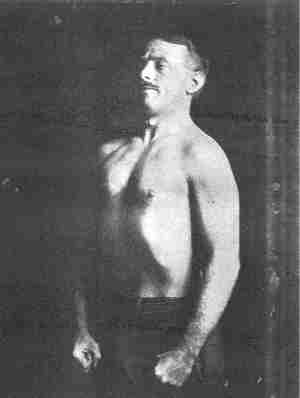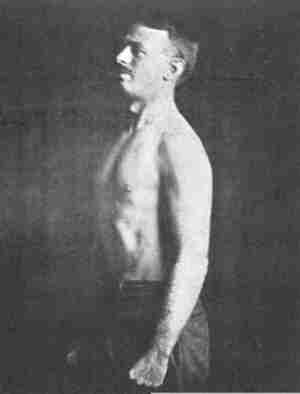This lesson shows clearly by means of two photographs the secret of Stahara Control, and teaches you how to apply it.

Fig 14: CENTER OF GRAVITY TOO HIGH -- INCORRECT
NO STRENGTH IN THE STAHARA -- THE ABDOMINAL REGION
Body weak -- easily unbalanced.
Connection between arms and legs absent.
Body cannot move quickly.

Fig 15: CENTER OF GRAVITY LOW -- CORRECT
THE STAHARA -- ABDOMINAL REGION -- FULL OF STRENGTH
Body strong -- well balanced.
Proper connection between arms and legs.
Body able to move quickly.
STAHARA CONTROL HELPS QUICK MOVEMENT
Dance around the room imitating the movements of a boxer -- this is called "shadow boxing." First raise your ribs as high as you can, as in fig. 14.
Next dance around with Stahara control, as in fig. 15. Note how much more under control your movements are, the connection between your arms and legs is much better; you can put more punch into your arm movements.
Stahara control teaches you to keep limber all over, even your Stahara is not tensed, and it enables you to concentrate all your effort in the proper muscles at the proper time.
AN EASY EXPERIMENT
TRY THIS
Stand at attention, head up, shoulders back. Throw your chest out, raising the ribs thus showing what physical culturists call "The Grecian Arch," as shown in fig. 14.
In this position let a friend seize your coat at the shoulders with finger and thumb of each hand, and slowly pull until you lose your balance and fall forward.
It takes but a small effort on his part as your center of balance is too high and your waistline is weak.
Again stand at attention, but do not raise your Grecian Arch. Tense your abdominal muscles, as shown in fig. 15 but without drawing the stomach in. Press the stomach out and against your belt.
Have your friend pull you forward as before. Stand still, do not move the feet. Note how much better you keep your balance.
He will note how much heavier you feel, and, using the same amount of strength as before he will be unable to pull you forward.
Try these two experiments on your friend. In number 1, use the minimum effort to unbalance him. In number 2, use the same amount of strength, and note how much heavier and stronger he is.
A man who has trained himself to stand and pose with the Grecian Arch showing will be at a disadvantage when he first begins to wrestle or box for when making an effort he will instinctively raise his chest walls.
This raises his center of balance too high and weakens his Stahara -- the connecting link between his arms and legs.
In the first experiment with no control of the Stahara the body is like a ship, made of good material, but in which the rivets are loose.
In the second, the ship is tight and trim, every rivet in its place and holding. Your body is like one solid beam, a trustworthy support for a weighty structure, rather than a pillar made of several timbers loosely bolted together and consequently weak.
Practise this experiment until your face shows no trace of effort and until you can do it easily, tensing only when he pulls and relaxing when he relaxes.
The awkwardness of many men can be traced to their unconsciously raising their Grecian Arch whenever they do anything requiring and effort.











